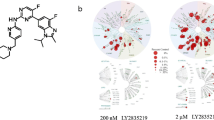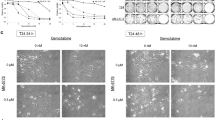Summary
Pharmacological inhibition of CHK1 in the absence of p53 functionality leads to abrogation of the S and G2/M DNA damage checkpoints. We report the preclinical therapeutic activity of LY2603618 (CHK1 inhibitor) at inhibiting CHK1 activation by gemcitabine and enhancing in vivo efficacy. The in vivo biochemical effects of CHK1 inhibition in the absence or presence of DNA damage were measured in human tumor xenograft models. Colon, lung and pancreatic xenografts models were treated with gemcitabine, LY2603618, or gemcitabine plus LY2603618. Gemcitabine treatment alone induced a significant increase in CHK1 autophosphorylation over untreated tumors. Co-administration of LY2603618 with gemcitabine showed a clear inhibition of CHK1 autophosphorylation for at least 24 h. Combining LY2603618 with gemcitabine resulted in an increase in H2AX serine 139 phosphorylation, indicating a corresponding increase in damaged DNA in the tumors. LY2603618 abrogated the S-phase DNA damage checkpoint in Calu-6 xenograft tumors treated with gemcitabine but did not significantly alter the G2/M checkpoint. Combining gemcitabine with LY2603618 resulted in a significant increase in tumor growth inhibition in Calu-6, HT-29 and PAXF 1869 xenografts over gemcitabine treatment alone. The best combination efficacy occurred when LY2603618 was given 24 h following dosing with gemcitabine. LY2603618 worked effectively to remove the S-phase DNA damage checkpoint and increase the DNA damage and the antitumor activity of gemcitabine treatment.








Similar content being viewed by others
References
Patil M, Pabla N, Dong Z (2013) Checkpoint kinase 1 in DNA damage response and cell cycle regulation. Cell Mol Life Sci: CMLS 70(21):4009–4021. doi:10.1007/s00018-013-1307-3
Taylor WR, Stark GR (2001) Regulation of the G2/M transition by p53. Oncogene 20(15):1803–1815. doi:10.1038/sj.onc.1204252
Dai Y, Grant S (2010) New insights into checkpoint kinase 1 in the DNA damage response signaling network. Clin Cancer Res : Off J Am Assoc Cancer Res 16(2):376–383. doi:10.1158/1078-0432.CCR-09-1029
Nam EA, Cortez D (2011) ATR signalling: more than meeting at the fork. Biochem J 436(3):527–536. doi:10.1042/BJ20102162
Huang P, Chubb S, Hertel LW, Grindey GB, Plunkett W (1991) Action of 2′,2′-difluorodeoxycytidine on DNA synthesis. Cancer Res 51(22):6110–6117
Koh SB, Courtin A, Boyce RJ, Boyle RG, Richards FM, Jodrell DI (2015) CHK1 inhibition synergizes with gemcitabine initially by destabilizing the DNA replication apparatus. Cancer Res 75(17):3583–3595. doi:10.1158/0008-5472.CAN-14-3347
Maity A, McKenna WG, Muschel RJ (1994) The molecular basis for cell cycle delays following ionizing radiation: a review. Radiother Oncol : J Eur Soc Ther Radiol Oncol 31(1):1–13
Walworth N, Davey S, Beach D (1993) Fission yeast chk1 protein kinase links the rad checkpoint pathway to cdc2. Nature 363(6427):368–371. doi:10.1038/363368a0
Zhang Y, Hunter T (2014) Roles of Chk1 in cell biology and cancer therapy. Int J Cancer J Int Cancer 134(5):1013–1023. doi:10.1002/ijc.28226
Carrassa L, Damia G (2011) Unleashing Chk1 in cancer therapy. Cell Cycle 10(13):2121–2128
Ewald B, Sampath D, Plunkett W (2007) H2AX phosphorylation marks gemcitabine-induced stalled replication forks and their collapse upon S-phase checkpoint abrogation. Mol Cancer Ther 6(4):1239–1248. doi:10.1158/1535-7163.MCT-06-0633
Toledo LI, Altmeyer M, Rask MB, Lukas C, Larsen DH, Povlsen LK, Bekker-Jensen S, Mailand N, Bartek J, Lukas J (2013) ATR prohibits replication catastrophe by preventing global exhaustion of RPA. Cell 155(5):1088–1103. doi:10.1016/j.cell.2013.10.043
Sakurikar N, Eastman A (2015) Will targeting Chk1 have a role in the future of cancer therapy? J Clin Oncol : Off J Am Soc Clin Oncol 33(9):1075–1077. doi:10.1200/JCO.2014.60.0767
Walton MI, Eve PD, Hayes A, Henley AT, Valenti MR, De Haven Brandon AK, Box G, Boxall KJ, Tall M, Swales K, Matthews TP, McHardy T, Lainchbury M, Osborne J, Hunter JE, Perkins ND, Aherne GW, Reader JC, Raynaud FI, Eccles SA, Collins I, Garrett MD (2015) The clinical development candidate CCT245737 is an orally active CHK1 inhibitor with preclinical activity in RAS mutant NSCLC and Emicro-MYC driven B-cell lymphoma. Oncotarget
Massey AJ, Stokes S, Browne H, Foloppe N, Fiumana A, Scrace S, Fallowfield M, Bedford S, Webb P, Baker L, Christie M, Drysdale MJ, Wood M (2015) Identification of novel, in vivo active Chk1 inhibitors utilizing structure guided drug design. Oncotarget
Weiss GJ, Donehower RC, Iyengar T, Ramanathan RK, Lewandowski K, Westin E, Hurt K, Hynes SM, Anthony SP, McKane S (2013) Phase I dose-escalation study to examine the safety and tolerability of LY2603618, a checkpoint 1 kinase inhibitor, administered 1 day after pemetrexed 500 mg/m(2) every 21 days in patients with cancer. Investig New Drugs 31(1):136–144. doi:10.1007/s10637-012-9815-9
Calvo E, Chen VJ, Marshall M, Ohnmacht U, Hynes SM, Kumm E, Diaz HB, Barnard D, Merzoug FF, Huber L, Kays L, Iversen P, Calles A, Voss B, Lin AB, Dickgreber N, Wehler T, Sebastian M (2014) Preclinical analyses and phase I evaluation of LY2603618 administered in combination with pemetrexed and cisplatin in patients with advanced cancer. Investig New Drugs 32(5):955–968. doi:10.1007/s10637-014-0114-5
Doi T, Yoshino T, Shitara K, Matsubara N, Fuse N, Naito Y, Uenaka K, Nakamura T, Hynes SM, Lin AB (2015) Phase I study of LY2603618, a CHK1 inhibitor, in combination with gemcitabine in Japanese patients with solid tumors. Anti-Cancer Drugs 26(10):1043–1053. doi:10.1097/CAD.0000000000000278
Tentler JJ, Tan AC, Weekes CD, Jimeno A, Leong S, Pitts TM, Arcaroli JJ, Messersmith WA, Eckhardt SG (2012) Patient-derived tumour xenografts as models for oncology drug development. Nat Rev Clin Oncol 9(6):338–350. doi:10.1038/nrclinonc.2012.61
King C, Diaz H, Barnard D, Barda D, Clawson D, Blosser W, Cox K, Guo S, Marshall M (2014) Characterization and preclinical development of LY2603618: a selective and potent Chk1 inhibitor. Investig New Drugs 32(2):213–226. doi:10.1007/s10637-013-0036-7
Merriman RL, Hertel LW, Schultz RM, Houghton PJ, Houghton JA, Rutherford PG, Tanzer LR, Boder GB, Grindey GB (1996) Comparison of the antitumor activity of gemcitabine and ara-C in a panel of human breast, colon, lung and pancreatic xenograft models. Investig New Drugs 14(3):243–247
Low J, Shuguang H, Dowless M, Blosser W, Vincent T, Davis S, Hodson J, Koller E, Marcusson E, Blanchard K, Stancato L (2007) High-content imaging analysis of the knockdown effects of validated siRNAs and antisense oligonucleotides. J Biomol Screen 12(6):775–788. doi:10.1177/1087057107302675
Li H, Durbin R (2009) Fast and accurate short read alignment with Burrows-Wheeler transform. Bioinformatics 25(14):1754–1760. doi:10.1093/bioinformatics/btp324
Li H, Handsaker B, Wysoker A, Fennell T, Ruan J, Homer N, Marth G, Abecasis G, Durbin R (2009) The sequence alignment/map format and SAMtools. Bioinformatics 25(16):2078–2079. doi:10.1093/bioinformatics/btp352
DePristo MA, Banks E, Poplin R, Garimella KV, Maguire JR, Hartl C, Philippakis AA, del Angel G, Rivas MA, Hanna M, McKenna A, Fennell TJ, Kernytsky AM, Sivachenko AY, Cibulskis K, Gabriel SB, Altshuler D, Daly MJ (2011) A framework for variation discovery and genotyping using next-generation DNA sequencing data. Nat Genet 43(5):491–498. doi:10.1038/ng.806
Garrison E, Marth G (2012) Haplotype-based variant detection from short-read sequencing. arXiv:12073907v2 [q-bioGN]
Hui YF, Reitz J (1997) Gemcitabine: a cytidine analogue active against solid tumors. Am J Health-Syst Pharm : AJHP : Off J Am Soc Health-Syst Pharm 54(2):162–170, quiz 197–168
Montano R, Thompson R, Chung I, Hou H, Khan N, Eastman A (2013) Sensitization of human cancer cells to gemcitabine by the Chk1 inhibitor MK-8776: cell cycle perturbation and impact of administration schedule in vitro and in vivo. BMC Cancer 13:604. doi:10.1186/1471-2407-13-604
Leung-Pineda V, Ryan CE, Piwnica-Worms H (2006) Phosphorylation of Chk1 by ATR is antagonized by a Chk1-regulated protein phosphatase 2A circuit. Mol Cell Biol 26(20):7529–7538. doi:10.1128/MCB.00447-06
Karnitz LM, Flatten KS, Wagner JM, Loegering D, Hackbarth JS, Arlander SJ, Vroman BT, Thomas MB, Baek YU, Hopkins KM, Lieberman HB, Chen J, Cliby WA, Kaufmann SH (2005) Gemcitabine-induced activation of checkpoint signaling pathways that affect tumor cell survival. Mol Pharmacol 68(6):1636–1644. doi:10.1124/mol.105.012716
Eriksson S, Graslund A, Skog S, Thelander L, Tribukait B (1984) Cell cycle-dependent regulation of mammalian ribonucleotide reductase. The S phase-correlated increase in subunit M2 is regulated by de novo protein synthesis. J Biol Chem 259(19):11695–11700
Del Nagro CJ, Choi J, Xiao Y, Rangell L, Mohan S, Pandita A, Zha J, Jackson PK, O’Brien T (2014) Chk1 inhibition in p53-deficient cell lines drives rapid chromosome fragmentation followed by caspase-independent cell death. Cell Cycle 13(2):303–314. doi:10.4161/cc.27055
Tao ZF, Lin NH (2006) Chk1 inhibitors for novel cancer treatment. Anti Cancer Agents Med Chem 6(4):377–388
Tang J, Erikson RL, Liu X (2006) Checkpoint kinase 1 (Chk1) is required for mitotic progression through negative regulation of polo-like kinase 1 (Plk1). Proc Natl Acad Sci U S A 103(32):11964–11969. doi:10.1073/pnas.0604987103
Parsels LA, Morgan MA, Tanska DM, Parsels JD, Palmer BD, Booth RJ, Denny WA, Canman CE, Kraker AJ, Lawrence TS, Maybaum J (2009) Gemcitabine sensitization by checkpoint kinase 1 inhibition correlates with inhibition of a Rad51 DNA damage response in pancreatic cancer cells. Mol Cancer Ther 8(1):45–54. doi:10.1158/1535-7163.MCT-08-0662
Morgan MA, Parsels LA, Parsels JD, Mesiwala AK, Maybaum J, Lawrence TS (2005) Role of checkpoint kinase 1 in preventing premature mitosis in response to gemcitabine. Cancer Res 65(15):6835–6842. doi:10.1158/0008-5472.CAN-04-2246
Matthews DJ, Yakes FM, Chen J, Tadano M, Bornheim L, Clary DO, Tai A, Wagner JM, Miller N, Kim YD, Robertson S, Murray L, Karnitz LM (2007) Pharmacological abrogation of S-phase checkpoint enhances the anti-tumor activity of gemcitabine in vivo. Cell Cycle 6(1):104–110
Ross WE, Bradley MO (1981) DNA double-stranded breaks in mammalian cells after exposure to intercalating agents. Biochim Biophys Acta 654(1):129–134
Gonzalez Besteiro MA, Gottifredi V (2015) The fork and the kinase: a DNA replication tale from a CHK1 perspective. Mutat Res Rev Mutat Res 763:168–180. doi:10.1016/j.mrrev.2014.10.003
Juan G, Traganos F, James WM, Ray JM, Roberge M, Sauve DM, Anderson H, Darzynkiewicz Z (1998) Histone H3 phosphorylation and expression of cyclins A and B1 measured in individual cells during their progression through G2 and mitosis. Cytometry 32(2):71–77
Miller CW, Ikezoe T, Krug U, Hofmann WK, Tavor S, Vegesna V, Tsukasaki K, Takeuchi S, Koeffler HP (2002) Mutations of the CHK2 gene are found in some osteosarcomas, but are rare in breast, lung, and ovarian tumors. Genes Chromosome Cancer 33(1):17–21
Ahn J, Urist M, Prives C (2004) The Chk2 protein kinase. DNA Repair 3(8–9):1039–1047. doi:10.1016/j.dnarep.2004.03.033
Chen T, Stephens PA, Middleton FK, Curtin NJ (2012) Targeting the S and G2 checkpoint to treat cancer. Drug Discov Today 17(5–6):194–202. doi:10.1016/j.drudis.2011.12.009
Acknowledgments
We would like to recognize the essential contributions of the original CHK1 biology and medicinal chemistry team members formerly located at Icos Pharmaceuticals: Phyllis Goldman, Erik Christenson, Darcey Clark, Jeff Dantzler, Frank Diaz, Heather Douanpanya, Francine Farouz, Ryan Holcomb, Angela Judkins, Adam Kashishian, Ed Kesicki, Kim McCaw, Harch Ooi, Vanessa Rada, Fuqiang Ruan, Alex Rudolf, Frank Stappenbeck, Janelle Taylor, Gene Thorsett, Jen Treiberg, Margaret Weidner and Steve White. We would also like to thank Steven Bray for DNA sequencing and analysis as well as Eric Westin and Aimee Bence Lin for intellectual input.
Author information
Authors and Affiliations
Corresponding author
Ethics declarations
Conflict of interest
The authors, Darlene Barnard, H. Bruce Diaz, Teresa Burke, Gregory Donoho, Richard Beckmann, Bonita Jones, David Barda, Constance King and Mark Marshall are all employees of the Eli Lilly Company, which supports the development of LY2603618.
Rights and permissions
About this article
Cite this article
Barnard, D., Diaz, H.B., Burke, T. et al. LY2603618, a selective CHK1 inhibitor, enhances the anti-tumor effect of gemcitabine in xenograft tumor models. Invest New Drugs 34, 49–60 (2016). https://doi.org/10.1007/s10637-015-0310-y
Received:
Accepted:
Published:
Issue Date:
DOI: https://doi.org/10.1007/s10637-015-0310-y




